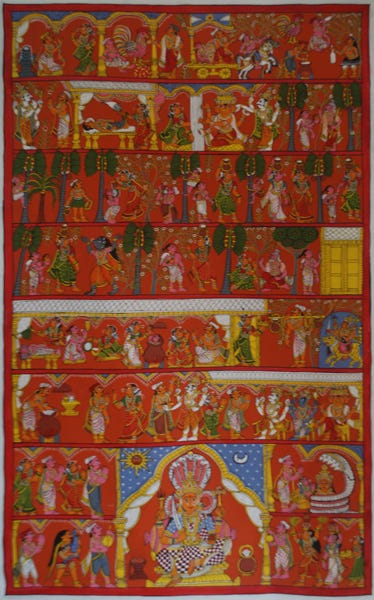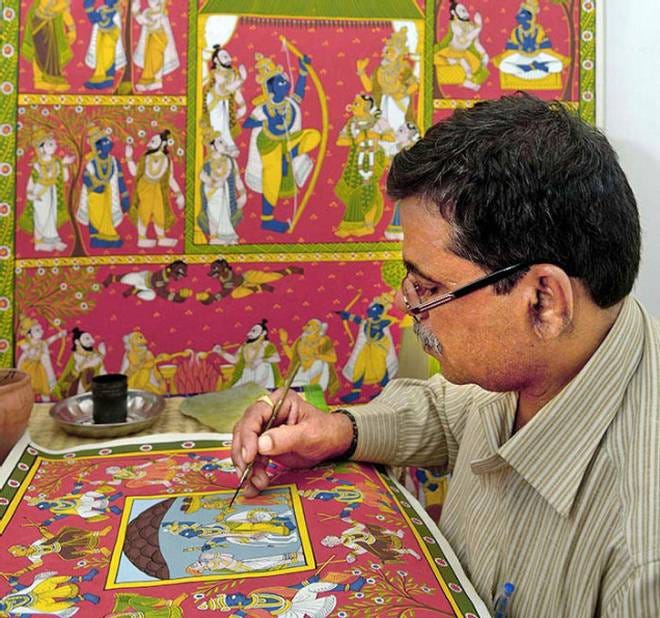
This pretty damsel perched on a chariot, pulled by what looked like two of the happiest horse puppies we have ever seen, was the most curious sight at a handicrafts exhibition we attended recently. ‘She is the Queen travelling through a forest on her chariot’ clarified Ramesh Vaikuntam when he caught me staring at her. ‘We have painted her with natural colours on Khadi. This is a Cheriyal painting.’ he added. And that intrigued us some more.
This is the first Cheriyal painting we had laid eyes on. In the Warangal District in Telangana, the Cheriyal village homes this beautiful art. Traditionally scroll paintings, these are a story telling medium for the Kathakalus or gypsy story tellers, who troupe though villages singing & enacting ballads from epics such as the Ramayana or Mahabharata.

Along with a portable stage & a musical choir that harmonizes with a tabala, harmonium & other local instruments, the Kathakalus carry with them hand painted scrolls that depict every scene they are narrating. The entire saga is painting within little rectangles on a textured Khadi fabric, 3 feet wide & up to 60 feet in length.
While each story is unique, all scrolls start with an ode to Ganapathy, the lord of wealth & Saraswathi, the goddess of learning.
While Kathakalus are the story tellers, it is the Chitrakaars who paint these stories.

D. Vaikuntam, National Award Winner of the Cheriyal Scroll Paintings, exclusive to Telangana is possibly the only Chitrakaar creating these scrolls & keeping the art alive today.
Vaikuntamji, unlike the flamboyant Kathakalus, is a shy man of a few chosen words who silently narrates these epics on canvas. Be it a vibrant Raas Leela, a fierce tiger hunting a galloping deer in the jungle or a demure bride in a Doli, his workmanship exudes the energy, excitement & culminating emotions, with or without the travelling orchestra.
Storytelling has a greater purpose
The Cheriyal Scrolls or for that matter the Kaavad, the Kathaputlis, the Pattachitras or the Shadow Puppets are all storytelling mediums. More than just travelling sagas, they are potent stories of virtuous Gods, fabled animals & invincible forces of nature that inspire courage, loyalty, truth, humility & much goodness in their audience.
The various art forms transpire into a mesmerizing audio/visual format that works beautifully in communicating even with an unlettered audience.

India has the richest storytelling culture worldover. Today however, storytelling is going through a metamorphosis with easily accessible & most times impassioned technologies like tv shows or the internet. Folk stories & folk art, with their local nuances, rustic dialects & varying versions of the same story are far & few. Vaikuntamji is one of the last few Nakhas tribal families in the Cheriyal village keeping the scroll paintings art form alive. The Kathakalus, Mandhets or storytellers are even fewer.

Overtime, the Chitrakaars are evolving into avid storytellers too. Instead of the longer scrolls, they paint shorter stories on smaller canvases or other mediums to make them collectible works of art that appeal to an urban audience.
Painting within the lines
Amidst the changing market dynamics, Vainkuntamji & his two sons try to keep the art as authentic & rooted. They still use the coarse Khadi fabric, treated with the paste of tamarind seeds, tree gum & white clay. The background of the paintings still retains the time-honoured red derived from the locally available ingilikam stone. Outlines of figurines are painted with a squirrel tailed brush. The colours of the face & skin still vary with the characters — blues for Gods & yellow for Goddesses, humans come in shades of pink while brown or darker shades are reserved for demons.
They still use natural colours. White obtained from grounded sea shells, black from lamp soot, yellow from pevidi stone, blue from indigo leaves & various vegetable dyes or ground stones for making a colour palette. Colours are mixed with thirumani tree gum, before use. (source: Rakesh Vainkuntam)
But as the demand for traditional scrolls dwindles, the paintings narrate shorter stories, sometimes from the epics & sometimes from the 7 distinct caste and communities of the Cheriyal village, namely the Madiga — the hajjam or barber, Goud — the toddy tapper, Mudiraju — the dhobi or washerman, Malas — the chamar or leather worker, Padmashali –the fisherman, Chakala — the weaver & Mangali — the farmer. Castes, with their intrinsic rituals, fascinating myths, numerous dieties, mundane routines & everyday life make vibrant subjects for the paintings. (source: https://en.wikipedia.org/wiki/Cheriyal_scroll_painting)


Traditional Chariyal paintings are still commissioned to Chitrakaars by the Kathakalus, who give the narrative or scripts that form the storyline for the art. Chitrakaars usually take about a year to complete these paintings. The less complicated & smaller paintings or objects of art usually take about a month or maybe 6 months to conceptualize & complete.
In the olden days of barter, the Chitrakaar received rice & coconuts as payments for his work. Carrying on this tradition, it is customary for the Storyteller, even today, to handover a coconut on receiving a completed painting.
No matter how deep rooted & charming traditions are, a dynamic & disorganized market has it’s uncertainties. The Chitrakaars could have moved to neighbouring cities for more secure jobs & incomes, but they choose to remain faithful to their folk art.
As we try to work out a schedule to meet Vainkuntamji, we understand that it is not just creating paintings that help this art. His sons & him dedicate a large part of the year travelling the country & even abroad for exhibitions or holding workshops in for children or with artistically inclined adults. That & various other things on their itinerary makes us appreciate the fact that our folk artists don’t create their magnificent work midst peace & tranquility. They have stringent deadlines to honour & above all a keen sense of economics.
But in their art, all we see is the romantic notions they create through each brush stroke. Afterall, Art would be doing half a job if it did not dust off the every day mundane to make our lives a little more beautiful.


aamori. live a little art.
